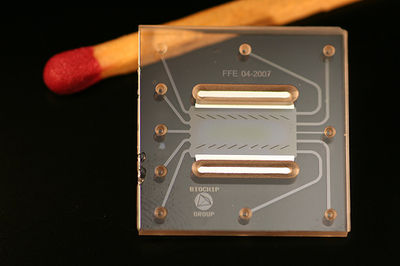Microfluidics: Difference between revisions
No edit summary |
|||
| Line 28: | Line 28: | ||
===Channel designs=== | ===Channel designs=== | ||
Are there online repositories of channel designs for different purposes? | Are there online repositories of channel designs for different purposes? | ||
[http://groups.csail.mit.edu/cag/micado/index.html Micado] is open-source software for designing microfluidic chips. | |||
==Materials and Equipment Used== | ==Materials and Equipment Used== | ||
Revision as of 17:43, 22 February 2011
Main > Food and Agriculture > Pests and weeds
Microfluidics refers to a set of technologies that control the flow of minute amounts of liquids or gases — typically measured in nano- and picoliters — in a miniaturized system.
Just as a computer chip has carefully-arranged wires that electricity moves around, a microfluidic chip has tiny channels etched onto it that fluids move around. In a biochemistry laboratory, a chemist might pipette some solution out of a flask, mix it with a reagent, fractionate it, or perform other operations on it. The interesting thing is that most of these processes are just a matter of moving liquids around, so they can be replicated with microfluidics. The advantage is that microfluidics is much cheaper, safer and requires less skill. Room-sized diagnostic testing equipment can be shrunk down to the size of a postage stamp. This is also called "lab-on-a-chip".
Applications are as vast as they are revolutionary, and include -
- Medical diagnostics and blood tests
- Medical and chemical research - testing for genes, chemical separation and reactions
- Environmental sensing - testing water quality, air quality, monitoring for environmental toxins
- Testing for plant diseases
- Testing soils (biosensor example here)
- mining
- developing biofuels
- and many more.
Microfluidics in Open Source Ecology
We are interested in very cheap, open-source ways of making microfluidic chips. There are plenty of groups working on this; it's a matter of gathering the information.
DIY microfluidics methods
- How to make a microfluidic chip using double-sided sellotape, glass slides and a scalpel: [1]. This requires inlet and outlet holes in the slide; perhaps these could be made with a laser cutter?
- Complex 3D microfluidic devices made with alternating layers of paper and double-sided tape: [2]. The tape was cut using a laser cutter. The paper was treated with photoresis (a light-sensitive polymer) and exposed to UV light when masked with a transparency with a pattern printed onto it. Cost of fabricating a chip = $0.03.
- Disposable microfluidic devices created using regular wax paper
- Shrinky Dink® microfluidics - academic paper here
Channel designs
Are there online repositories of channel designs for different purposes?
Micado is open-source software for designing microfluidic chips.
Materials and Equipment Used
Consumables:
- blotter paper
- regular paper
- wax paper, shrinky-dink
- transparency film
- cotton thread
- sewing needles
- wood sticks
- Jell-O
- beeswax?
Equipment:
- syringes
- cell phone cameras
- plastic lenses for cheap microscopes
- Laser cutter, see Low-cost rapid prototyping of flexible microfluidic devices using a desktop digital craft cutter
George Whitesides, Harvard University
In his legendary career in chemistry, George Whitesides has been a pioneer in microfabrication and nanoscale self-assembly. Now, he's fabbing a diagnostic lab on a chip.
Further Reading
- Wikipedia: Microfluidics and Lab-on-a-chip
- DIY Bio
- Diagnostics For All
- Daktari
